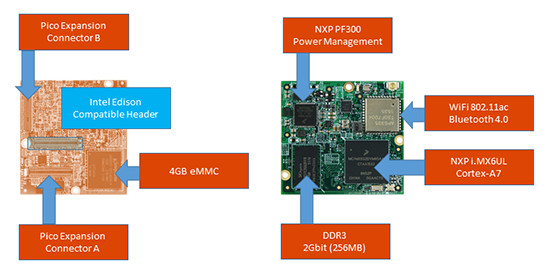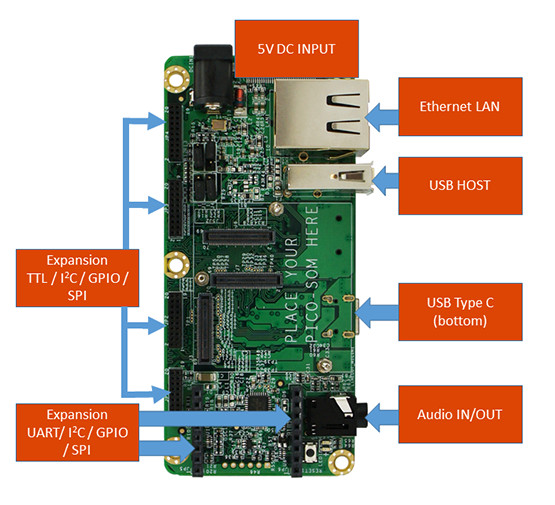Wandboard was one of the first to launch boards based on Freescale i.MX6 Solo, Dual and Quad in early 2013. The boards are comprise of an EDM system-on-module and a carrierboard, that makes it not only suitable as a single board computer, but you could also use the boards to start developing software, while making your own carrierboard to match your application. Wandboard.org community sent me an email last night to let me know about their latest board called Hobbitboard, or in full “Hobbitboard Made for Brillo”, powered by NXP i.MX6 UltraLite Cortex A7 processor, which follows the same principle, and includes Hobbit Compute Module and Hobbit I/O Carrierboard.

Hobbit Compute Module specifications:
- SoC – NXP i.MX6 UltraLite Cortex A7 processor @ 528 MHz
- System Memory – 256MB DDR3
- Storage – 4GB eMMC flash
- Connectivity – 802.11ac WiFi and Bluetooth 4.0 (Ampak AP6335)
- Board Connectors – Two Pico Expansion header and one Intel Editon compatible headers
- Power Management – NXP PF300
- Dimensions – 40 x 36 mm
If the design look familiar, especially with the Intel Edison compatible design, it’s because Hobbit Compute Module appears to be a variation of TechNexion PICO-iMX6 System-on-Module with the new NXP, previously Freescale, i.MX 6UltraLite processor and less RAM, and even a closer variation of the new PICO-IMX6UL SoM, also used for Brillo.

To get started with development easily, Wandboard also designed Hobbit I/O Carrierboard with the following specifications:
- SoM Connectors – 2x Pico header and 1x Edison compatible header
- Connectivity – Ethernet port (RJ45)
- USB – 1x USB host port, 1x USB type C port
- Audio – 3.5mm audio In/Out jack
- Expansion Headers
- Two 8-pin headers with UART, I2C, GPIO and SPI signals (2.54mm pitch)
- Four 2×10-pin headers with TTl, I2C, GPIo and SPI signals
- Power Supply – 5V via power barrel
- Dimensions – 100 x 45mm
As the name implies, the board has been made to run Google’s Brillo operating system for the Internet of Things, and targets applications such as home automation, drones, 3D printer, climate control, robot or remote sensor network, and more.
Hobbitboard can be pre-ordered on ARMKits for $69, and it’s also listed on AVNET for $90.04 and DigiKey for $81.24, with shipping scheduled for the end of March. The code name for the board is HOBBIT6UL-BRILLO, which implied there could also be another version later on. Documentation is currently limited, but should be shortly available on Hobbitboard Brillo product page.

Jean-Luc started CNX Software in 2010 as a part-time endeavor, before quitting his job as a software engineering manager, and starting to write daily news, and reviews full time later in 2011.
Support CNX Software! Donate via cryptocurrencies, become a Patron on Patreon, or purchase goods on Amazon or Aliexpress





$69… why?
That shouldn’t be more than $20-25 worth of components…
@TLS
I didn’t see any board with freescale’s imx6 soc not overpriced. freescale has gotten kind of an ‘apple’ syndrome – they think they’re the only vendor on the planet and may sell their (very outdated) socs for doubled/tripled price.
@cortex-a72
You are too low in your BOM estimates. That CPU module has a $25 BOM. AP6335 is $7 or so. Then you have to add on the baseboard. AP6335 is dual band 2.4/5Ghz 11ac
You could probably make a $25 board with this CPU, but not with this design.
RK3288 Firefly has similar chips and it is $160.
@Jon Smirl
Does it actually come with the base board though? It’s not clear if that’s optional or not.
If it comes with it, it’s a bit more bearable, but still expensive for what it is.
This is technically speaking an RPi 2 with Wi-Fi and some eMMC thrown in, but less RAM and a much slower SoC.
@cortex-a72
Well, the SoC is $4.11, so for once it’s not a crazy expensive chip, but yeah, you’re right, a lot of their solutions are heavily overpriced, kin of like TI. It’s a real shame, as they’re some of the most easily accessible solutions, but it doesn’t make sense making high volume products based in their chips.
I think it comes with the baseboard. It is being advertised as a Brillo development board. Not too useful as a development board without that baseboard.
Freescale/TI CPUs as very expensive compared to Chinese ones. I think that is just a reflection of these chips being designed and supported in the USA with US engineering wage costs. Both of these chips have way, way better software support than their Chinese counter parts.
Since many western SoCs companies like TI & Freescale could not compete on price, they’ve decided to re-orient their business to industrial, automotive, or healthcare sector. You don’t care that much whether a chip is $5 or $10 on a $30,000 car, and even less if your board is going to be used for mining operations, you just want something that works.
@cnxsoft
Fair comment, but at the same time, both companies are pretending to cater towards makers/hackers etc. which they clearly aren’t with the kind of prices they’re asking for, as it’s simply not possible to make a sensible end product using their chips, at least if you’re trying to make a low-cost consumer product.
@TLS
TI revenue is $13 billion a year, so someone is buying their chips. It is far larger that all of the Chinese SOC makers combined. NXP just acquired Freescale, I think the combined revenue will be about $8 billion.
It is still questionable if the Chinese SOC industry will be around ten years from now. They don’t disclose earnings but I think most of them are losing a lot of money.
Freescale/NXP does not overcharge for iMX processors. You get what you pay for–reliability, availability, and support.
iMX processors are extremely reliable and are used in harsh environments such as automotive and avionics. You really want to use a cheap Chinese processor there? Maybe OK for a cruddy consumer gadget to use a cheap processor with a year life expectancy.
iMX processors are available in small quantities from major distributors. You can buy 1 or millions.
Want to build your own product with the ARM processor used on a Raspberry Pi? Forget it, unless you buy 1 Million pieces.
Need comprehensive documentation? NXP data sheets and reference manuals are thousands of pages and highly detailed. Plus millions of line of documented source code are available.
Support is available directly from NXP or one of their distributors such as Arrow and Avnet (and to a lesser extent Digikey and Mouser). Both NXP and their distribution partners have field application engineers available to answer questions.
NXP/Freescale products have longevity. When you buy one of these parts, you’ll be able to continue buying them for 10+ years (15+ for automotive and medical). I know of one company that recently needed to purchase MC68K processors for one last production run of a medical iv pump. And guess what? They were able to! Not many semiconductor companies can do that.
And even though NXP is a multi-billion dollar company, they sell much more than iMX processors.
@Brad Stewart
I guess you’re working for NXP/Freescale, right?
> iMX processors are extremely reliable and are used in harsh environments such as automotive
> and avionics. You really want to use a cheap Chinese processor there? Maybe OK for a cruddy
> consumer gadget to use a cheap processor with a year life expectancy.
Agree.
> iMX processors are available in small quantities from major distributors. You can buy 1 or millions.
> Want to build your own product with the ARM processor used on a Raspberry Pi?
> Forget it, unless you buy 1 Million pieces.
Also agree.
> NXP data sheets and reference manuals are thousands of pages and highly detailed.
Strongly disagree about the “highly detailed” part. The manuals are sometimes inconsistent and descriptions of functionality often only scratches the surface. I’ll eat my hat if someone is able to use the IPUv3 and all it’s functionality with the available documentation in the manuals.
> Plus millions of line of documented source code are available.
I must have missed that. At least the FSL linux kernel and linux userspace tools/libraries are documented badly and are of bad quality.
> Both NXP and their distribution partners have field application engineers available to answer questions.
Well, the iMX community is most of the times not helpful and it can take months to get answers/solutions from FAEs.